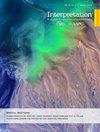Imaging distributed acoustic sensing-to-geophone conversion data: A field application to CO2 sequestration data
IF 1.1
4区 地球科学
Q3 GEOCHEMISTRY & GEOPHYSICS
Interpretation-A Journal of Subsurface Characterization
Pub Date : 2023-02-27
DOI:10.1190/int-2022-0098.1
引用次数: 0
Abstract
Compared with conventional geophone data, distributed fiber-optic sensing, including distributed acoustic sensing (DAS), can provide better spatial coverage for imaging the subsurface with finer spatial sampling. Because DAS measures subsurface seismic responses differently than the geophone, imaging technologies (e.g., reverse time migration and full-waveform inversion) that are developed for conventional geophone data cannot be readily applied to original DAS data without causing uncertainties in phase or depth, especially when one compares the DAS imaging results against the usual geophone imaging results. Based on vertical seismic profile field data from a CO2 sequestration site, we have compared the imaging results of the CO2 storage reservoir associated with the DAS and the geophone data, respectively, and we illustrate the differences between the imaging results of the DAS and geophone data. The difference between the DAS and geophone imaging results could be critical in obtaining time-lapse signals for monitoring reservoir changes, e.g., in subsurface CO2 sequestration. We develop to convert DAS to geophone data so that we can reduce the discrepancies between DAS and geophone imaging results and we therefore can reuse existing seismic imaging technologies. Two conversion methods, one physics-based and one deep-learning (DL)-based, are used for the DAS-to-geophone transformation. Field data results demonstrate that the DL-based approach can better successfully improve the alignment between the DAS and geophone images, whereas the physics-based solution is constrained by its assumption.成像分布式声学传感到检波器转换数据:CO2封存数据的现场应用
与传统检波器数据相比,分布式光纤传感,包括分布式声传感(DAS),可以提供更好的空间覆盖,以更精细的空间采样进行地下成像。由于DAS测量的地下地震响应与检波器不同,因此为传统检波器数据开发的成像技术(例如逆时偏移和全波形反演)不能很容易地应用于原始DAS数据,而不会造成相位或深度的不确定性,特别是当将DAS成像结果与常规检波器成像结果进行比较时。基于某CO2封存点的垂直地震剖面现场数据,我们分别比较了DAS与检波器数据相关联的CO2储层成像结果,并说明了DAS与检波器数据成像结果的差异。DAS和检波器成像结果之间的差异对于获得监测储层变化的延时信号至关重要,例如,在地下CO2封存中。我们开发了将DAS转换为检波器数据的方法,以减少DAS和检波器成像结果之间的差异,从而可以重用现有的地震成像技术。两种转换方法,一种是基于物理的,一种是基于深度学习(DL)的,用于das到检波器的转换。现场数据结果表明,基于dl的方法可以更好地改善DAS与检波器图像之间的对齐,而基于物理的解决方案则受到其假设的限制。
本文章由计算机程序翻译,如有差异,请以英文原文为准。
求助全文
约1分钟内获得全文
求助全文
来源期刊

Interpretation-A Journal of Subsurface Characterization
GEOCHEMISTRY & GEOPHYSICS-
CiteScore
2.50
自引率
8.30%
发文量
126
期刊介绍:
***Jointly published by the American Association of Petroleum Geologists (AAPG) and the Society of Exploration Geophysicists (SEG)***
Interpretation is a new, peer-reviewed journal for advancing the practice of subsurface interpretation.
 求助内容:
求助内容: 应助结果提醒方式:
应助结果提醒方式:


